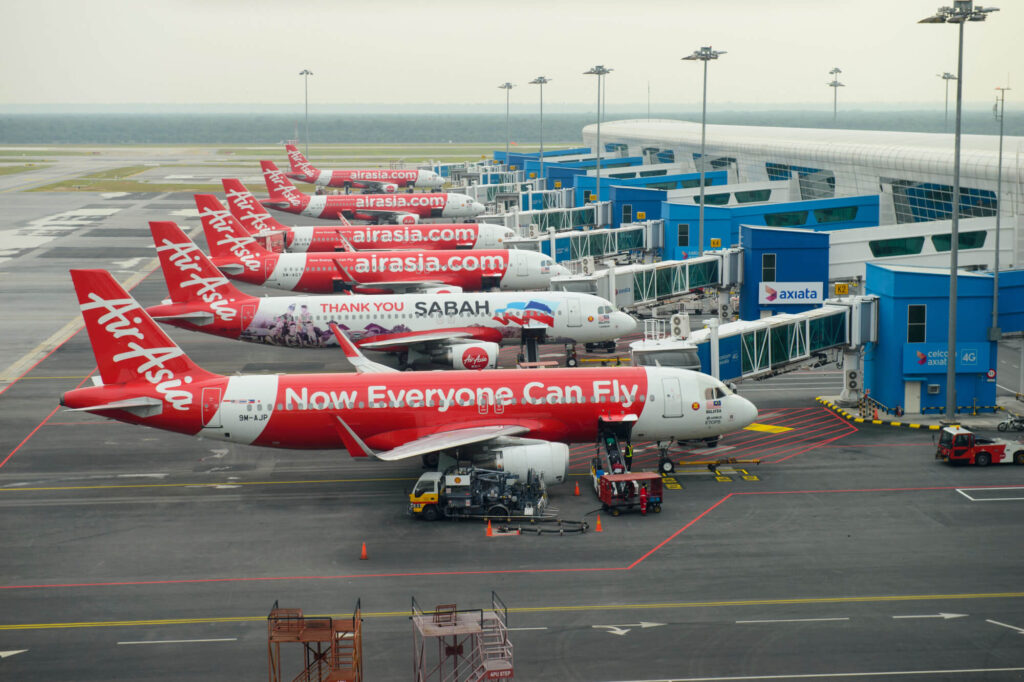While Capital A, formerly known as AirAsia, managed to grow its profits by 563% Year-on-Year (YoY) and finish Q3 2022 with positive Earnings before interest, taxes, depreciation, and amortization (EBITDA), the net loss still equaled RM1.1 billion ($249.7 million).
The group’s airlines painted a similar picture. The four short-haul low-cost carriers based in Malaysia, Thailand, Indonesia, and the Philippines, increased their revenue by 685% YoY to RM1.8 billion ($408.6 million) and finished the same quarter with an EBITDA of RM107 million ($24.2 million). The group’s financial statement did not specify whether its airlines or any other business segments were profitable or loss-making, only indicating a Q3 2022 loss of RM1.1 billion ($249.7 million).
Capacity tied to recovery
The meteoric rise in revenue was driven by “a strong and encouraging uptrend in performance benefited from the lifting of international travel restrictions in most of our core markets, which led to an upsurge in air travel demand for our ASEAN markets in particular,” noted the airline segment’s press release about the financial results.
Another positive sign in terms of revenue was the 1412% rise in ancillary revenue, with the four airlines managing to bag RM290.4 million ($64.9 million) of extra income following personalization of offers “based on data analytics improved ancillary target marketing,” the results announcement stated. However, costs ran rampant: while the Revenue per Available Seat Kilometer (ASK) was 5.26 US cents, the Cost per ASK was 6.73 US Cents. Excluding fuel, Cost per ASK was 4.19 US Cents.
In total, out of the 205 aircraft it owns, 125 were operational by the end of the third quarter of the year. By Q2 2023, AirAsia anticipates operating all 205 jets to serve passengers across the region. Overall, the group restored 52% of its pre-pandemic capacity by September 30, 2022. Capital A anticipates increasing its deployed seat number to 62% of levels previously seen in 2019.
“For our airlines under AAAGL [AirAsia Aviation Group – ed. note] we expect improving performance ahead as we anticipate some tailwinds in aviation – oil prices are going down, the ASEAN currencies are strengthening against the US dollar, and any recession will actually be a positive for us in the low-cost aviation space as people trade down to shorter flights and cheaper flights,” commented on the airlines’ situation Tony Fernandes, the CEO of Capital A.
Exiting PN17 and potential merger with AirAsia X
First marked as a Practice Notice 17 (PN17) – meaning a company under significant financial distress – in July 2020, but relieved of the status due to measures by Bursa Malaysia and the local Securities Commission.
In January 2022, shortly before AirAsia rebranded to Capital A, Bursa Malaysia, the local stock exchange, deemed it a PN17 company. Its long-haul low-cost sister AirAsia X, a completely different entity from Capital A’s airline portfolio, was also designated a PN17 company in October 2021. The long-haul carrier completed its restructuring in March 2022.
Now, the Fernandes-led group of airlines are looking to merge under one umbrella.
“The plan envisaged will entail the disposal of Capital A’s aviation businesses, namely AirAsia Berhad and AirAsia Aviation Group Limited, to AirAsia X Berhad (AAX). The shares consideration, received in exchange for the disposal, will then be distributed to Capital A shareholders, so that they will retain a direct interest in the aviation businesses via AAX, following the restructuring,” Fernandes indicated.
Meanwhile, AirAsia X’s CEO Benyamin Ismail added that while operations will remain separate following the merger, the ability to leverage a joint network of 130 destinations “us the opportunities to expedite our recovery after the completion of the regularisation plan.”
“We will make the necessary announcement in relation to further material developments accordingly,” Ismail concluded.
